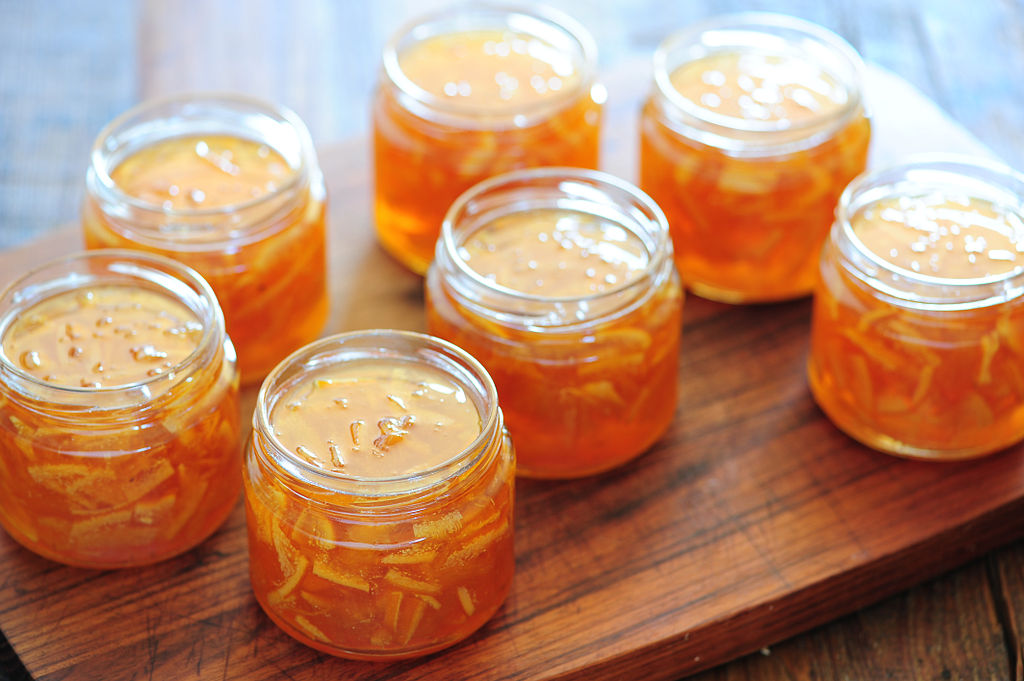I’m sure it isn’t often that the making of marmalade is mentioned in the daily parliamentary Hansard reports, but on October 29 1952, Miss Dorothy Carter, a well-known producer of preserves in Iden, was included in Hansard for the House of Lords. Miss Carter made jam and marmalade in the old-fashioned way, over a wood fire, in large copper pans. They were sold in Miss Coleman’s shop, a whole range of tasty, home-made goods – marmalade, jelly and jam. They were popular in Rye and the surrounding villages and then, further afield, at Fortnum and Mason and Jackson’s of Piccadilly, the other, now sadly gone, temple of grocery excellence. Queen Mary is even said to have called in, on one of her private visits to the area. They were numbered amongst the provisions taken on an expedition to climb Nun Kun mountain in 1988. But all was not good in the land of tasty preserves. Miss Carter fell foul of the law and was prosecuted, for adding less sugar than the Ministry of Food deemed necessary. Seems to me a strange thing, as rationing was still in force.
That most British word, marmalade, is not, surprisingly, British. It’s actually derived from the Portuguese word marmeleda. Now almost exclusively made from citrus fruit, in the past the word was used for preserves made from non-citrus fruit. Now a staple of the British breakfast table, we didn’t originally eat it then, but as a sort of dessert. Whatever next?
Marmalade was originally made from the quince. The ancient Greeks, and then, learning from them, the Romans, found that quinces cooked with honey, would make a very set preserve. The fifth century Roman cookbook, Apicius (otherwise known as De Re Culinaria or De Re Coquinaria, ) meaning On the Subject of Cookery, gives a recipe for preserving the whole quince, including the leaves, in a pot of honey, producing defrutum – the Roman version of marmalade.
King Henry VIII was given as a gift in 1524, “a box of marmalade from Mr Hull of Exeter”. This was most likely to have been the solid quince paste called marmelada – hence a box of it, rather than a jar. We find it again in 1530, when marmalet was part of the wedding feast of the daughter of a Yorkshire gentleman, John Neville.
On May 12 1534, William Grelt wrote to Lord Lisle: “I have sent to your lordship a box of marmaladoo, and another unto my good lady your wife.” On December 14 1536, Richard Lee wrote to Lord Lisle that, “he most heartily thanketh her Ladyship for her marmalado.” Poor Anne Boleyn enjoyed it as a special treat, sharing it with her ladies in waiting.
Eliza Cholmondley of Cheshire left a recipe book, dating from 1677. She gives one of the first recipes for marmalade, calling it Marmalet of Oranges, which seems to have been a dark and solid mass. The resourceful Scots, perhaps trying to save money by making it go further, added more water to their marmalade, making it more spreadable.
The first book to print a marmalade recipe was A Collection of above Three Hundred Receipts, published by Mary Kettilby in 1714. This used whole oranges, lemon juice and sugar. The lemon juice helped the mixture to set. Mrs Kettilby tells her readers to “boil the whole pretty fast ‘till it will jelly”. This is the first mention of marmalade as a jellied substance. She then says to pour the mixture into glasses, cover them and let them set. This recipe will have been the first to have had the clearer appearance of modern marmalade.
The Scots were the first to move the consumption of marmalade from a sort of dinnertime dessert to a breakfast accompaniment, quickly followed by the English. The diarist James Boswell records that when he and the lexicographer Dr Samuel Johnson visited Scotland in 1773, it was given at breakfast. The American writer of Little Women, Louisa May Alcott, visited England in 1870 and described, “a choice pot of marmalade and a slice of cold ham,” as the “essentials of English table comfort”.
Dundee in Scotland is associated with marmalade. James Keiler, together with his mother, had a shop selling sweets and preserves in the town. Together they opened a factory in 1797, to produce, ‘Dundee marmalade,’ known for the addition of thick pieces of Seville orange rind.
Marmalade makes an appearance in Jane Austen’s Sense and Sensibility, published in 1811, when a pernickety three year old is fed apricot marmalade when suffering a slight scratch from a hairpin.
The Queen of Crime writing, Dame Agatha Christie, used marmalade as the means of hiding a bitter poison made from yews, to poison the odious Rex Fortescue in A Pocketful of Rye, first published in 1953.
Who can forget the appearance of a slightly uncouth Paddington Bear with the late Queen during the Platinum Jubilee, shortly before Her Majesty’s death in 2022? It was then that the nation finally learned what it was that Her Majesty kept in her omnipresent handbag, a marmalade sandwich, “for later”. It obviously struck a chord, because after Her Majesty’s death on September 8 of that year, amongst the thousands of floral tributes left at the royal palaces and royal parks were countless marmalade sandwiches. There were so many that the Royal Parks agency had to send out a message that, “We are asking people not to leave marmalade sandwiches because of the negative impact on the park’s wildlife.”
Image Credits: Jules/Wikimedia Commons https://creativecommons.org/licenses/by/2.0/deed.en .



